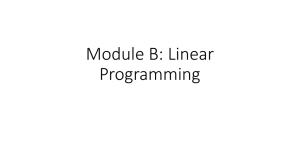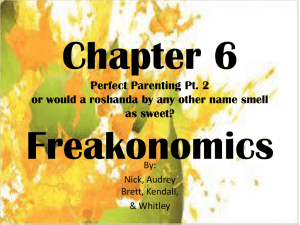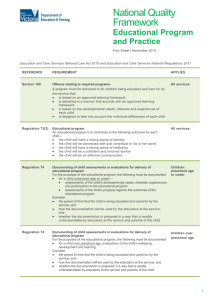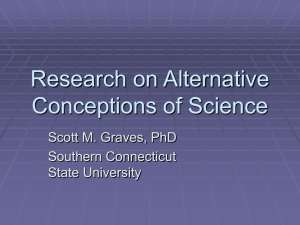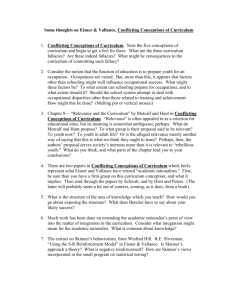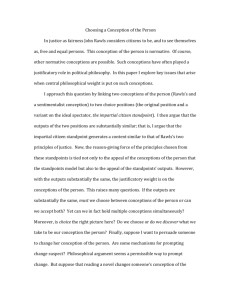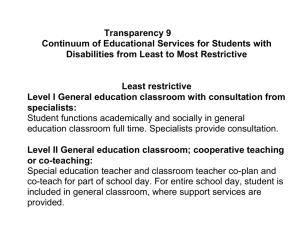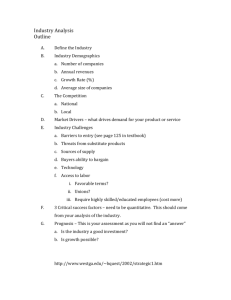Reflection Assignment:
advertisement
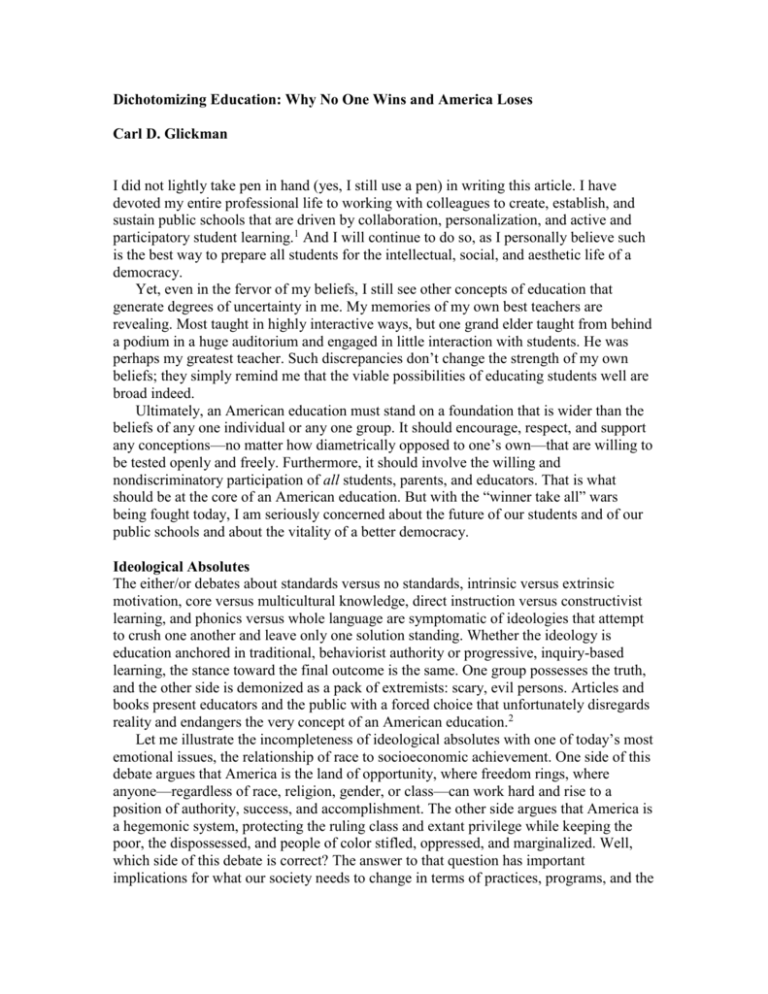
Dichotomizing Education: Why No One Wins and America Loses Carl D. Glickman I did not lightly take pen in hand (yes, I still use a pen) in writing this article. I have devoted my entire professional life to working with colleagues to create, establish, and sustain public schools that are driven by collaboration, personalization, and active and participatory student learning.1 And I will continue to do so, as I personally believe such is the best way to prepare all students for the intellectual, social, and aesthetic life of a democracy. Yet, even in the fervor of my beliefs, I still see other concepts of education that generate degrees of uncertainty in me. My memories of my own best teachers are revealing. Most taught in highly interactive ways, but one grand elder taught from behind a podium in a huge auditorium and engaged in little interaction with students. He was perhaps my greatest teacher. Such discrepancies don’t change the strength of my own beliefs; they simply remind me that the viable possibilities of educating students well are broad indeed. Ultimately, an American education must stand on a foundation that is wider than the beliefs of any one individual or any one group. It should encourage, respect, and support any conceptions—no matter how diametrically opposed to one’s own—that are willing to be tested openly and freely. Furthermore, it should involve the willing and nondiscriminatory participation of all students, parents, and educators. That is what should be at the core of an American education. But with the “winner take all” wars being fought today, I am seriously concerned about the future of our students and of our public schools and about the vitality of a better democracy. Ideological Absolutes The either/or debates about standards versus no standards, intrinsic versus extrinsic motivation, core versus multicultural knowledge, direct instruction versus constructivist learning, and phonics versus whole language are symptomatic of ideologies that attempt to crush one another and leave only one solution standing. Whether the ideology is education anchored in traditional, behaviorist authority or progressive, inquiry-based learning, the stance toward the final outcome is the same. One group possesses the truth, and the other side is demonized as a pack of extremists: scary, evil persons. Articles and books present educators and the public with a forced choice that unfortunately disregards reality and endangers the very concept of an American education.2 Let me illustrate the incompleteness of ideological absolutes with one of today’s most emotional issues, the relationship of race to socioeconomic achievement. One side of this debate argues that America is the land of opportunity, where freedom rings, where anyone—regardless of race, religion, gender, or class—can work hard and rise to a position of authority, success, and accomplishment. The other side argues that America is a hegemonic system, protecting the ruling class and extant privilege while keeping the poor, the dispossessed, and people of color stifled, oppressed, and marginalized. Well, which side of this debate is correct? The answer to that question has important implications for what our society needs to change in terms of practices, programs, and the targeting of resources. But the truth is that both contradictory realities have compelling evidence and must be used together to figure out what needs to be done next. Consider the economic component of this debate. Seymour Martin Lipset compares the United States with other Western industrialized nations.3 Since the post-Civil War era, America has been the wealthiest country, with a steady rise in living standards and unparalleled social and economic advances for the poor and working class. Yet the income of the poorest fifth of this nation continues to decline relative to that of other Americans. The African American scholar Henry Louis Gates, Jr., takes on this same dichotomy in reference to race. He observes that, since 1967, the number of middle-class African American families has quadrupled. Since 1973 the top 100 African American businesses have moved from sales of $473 million to $11.7 billion. In 1970 “only one in ten blacks had attended college; today one in three has.” He then goes on to discuss the continuous wrenching poverty of a third of African Americans today and concludes: “We need something we don’t have: a way of speaking about black poverty that doesn’t falsify the reality of black advancement, a way of speaking about black advancement that doesn’t distort the enduring realities of black poverty. I’d venture that a lot depends on whether we get it.”4 In truth, America has been one of the leading countries of opportunity for disenfranchised persons and, at the same time, a country of the greatest economic stratification between the luxury of the wealthiest and the wretched conditions of the poorest.5 In essence, the beliefs of Ayn Rand and Pete Seeger are both correct. To speak only of one side and ignore the other is to create disbelief in most ordinary citizens, who know firsthand of counterexamples to any single view. And this is what I believe to be the danger of ideological truth in education. Many educators in classrooms and schools feel that they have become pawns in the reformers’ and policy makers’ propaganda game that insists there is a single best way to change the system of American schools. Ideology in Education The attacks by E. D. Hirsch, Jr., against progressive education and the equally strident attacks by others such as Alfie Kohn against traditional education are wonderful examples of this either/or ideological stance. Hirsch argues that a common core of knowledge is essential for all students, if they are to succeed in mainstream society. Without a common framework of spoken and written English, historical and cultural references, and direct instruction, marginalized and poor children are deprived of the education that wealthier children pick up automatically from their parents and peers. Thus there is the need to rid our schools of the overwhelming “permissive” practices of activity-based education and to use tests of common knowledge to ensure that all children are acquiring the “cultural capital” needed for success in later life. Kohn in turn speaks against standards, core knowledge, and tests and says that children, regardless of their circumstances, are innately curious and that teachers should explore the topics that intrigue them to open up new freedoms and possibilities. Each proponent has his version of “truth.” Each sees little validity in any research supporting the methods that oppose his ideology. Again, the reality is that education is composed of many complexities that defeat any singular truth of how the world can and should work. For example, might it be that both Hirsch and Kohn have valid perspectives? Focusing on core knowledge that students themselves might not choose but that gives them access to a society in which they might possibly change the current balance of power, wealth, and control seems quite reasonable. Using the curiosity of students to learn multiple histories and cultures and to explore a variety of intelligences in an intensely involving way also seems quite reasonable. It is important that schools be joyful and engaging places. Yet is all learning intrinsically or extrinsically motivated? Most would say it’s both—we learn for the joy of it, but some of the most useful learning has taken place because others, not we ourselves, demanded that we do it, do it well, and do it until we got it right. The polemics surrounding standards versus no standards do not account for complex realities. Are external standards bad or good? Might they be both? Might we have state standards and assessments for most (but not all) public schools in the same state? Some states have standards and assessments that have been well received by educators and the public—not seen as heavy-handed, intrusive, or unfair. Many states have standards and assessments that are volatile in makeup, format, pressure, and consequences. The standards polarization—again, only one side can win—has come about because people have applied the term “standards” to all systems as if they were identical. However, Maine’s standards are quite different from Virginia’s. Elements of standards systems can be quite good, such as using disaggregated data to focus on the progress of all students, equalizing funding for poor students and communities, and targeting additional resources. Some states grant variances allowing schools and districts to develop their own assessments. And yes, there are cases in which it is good that standards can be used to close and reorganize schools that have done a disservice to students and parents. Standards systems can be demeaning and harmful—when they equate education with narrowly derived assessments and tests. They can also be tremendously positive in challenging schools and communities to leave no student behind.6 We need to acknowledge simultaneous realities if we are to educate all students better than before. Pedagogical Pain The “single-truth” wars have created much pain among teachers and school leaders who are swept into the battles. When whole language gained currency as “the” way to teach reading, teachers using phonics were lambasted, swept aside, and made to feel that they were evil, archaic, fascist practitioners of an indefensible method. Recently, the opposing force has “won” in states led by California and Texas. They have blamed whole language and invented spelling for declining literacy in America. Now teachers of whole language are made to feel abandoned and rejected as “feel-good,” self-esteem-promoting contributors to the demise of basic skills. These periodic surges and countersurges occur because one set of believers ignores any possible merits of the other side. Isn’t it possible that many highly literate and culturally diverse people—people that you and I both know—were taught how to read mainly by decoding, phonics, and grammatical rules? Isn’t it equally obvious that many highly literate and culturally diverse people have learned to read through literacy immersion, writing workshops, and experiential learning? Why is it so difficult to accept that an open mind about possibilities in education should be seen as a virtue rather than a liability? Cooperative versus competitive learning is another such brawl. Cooperation is a key aspect of how one learns with and from others, and it undergirds much of community, civic, and business life. Research exists that demonstrates the power of structured team activities for academic and social development. Yet humans, as part of the animal kingdom, are also moved to learn by traits that have helped them to survive: dominance, power, and the need to test oneself against others. Cooperation and competition are not different versions of humanity; they are different dimensions of the same humanity. And thus there is evidence that both cooperation and competition bring out high performance in individuals. The overarching debate about progressive, learner-centered schools versus teachercentered, direct-instruction schools will be my last venture into the foolishness of single truths. This debate simplifies and silences the cultural and family values that Lisa Delpit so eloquently writes about in Other People’s Children.7 Asking students to conform to certain manners, expecting them to learn what adults determine is important for them, being didactic in instruction, and using “call and response” methods have resulted in great success for teachers and leaders such as Marva Collins, Jaime Escalante, and Lorraine Monroe and for a number of school programs.8 Regardless of what one personally believes about the atmosphere of such classrooms and schools, students and parents in these settings see such didactic methods as expressions of teachers’ love, care, and cultural solidarity.9 The teachers are proud to demand that their students learn, and they go to almost any length to see that their students can compete with other students. Yet progressive classrooms and schools that are activity- or project-centered and that cultivate imagination, problem solving, responsibility, and a variety of intellectual pursuits have, in the hands of the most dedicated teachers, also attained incredible success for students. Educators such as Eliot Wigginton, Deborah Meier, George Wood, Gloria Ladson-Billings, Sonia Nieto, and Jabari Mahiri have shown the power of inquirycentered, progressive learning. My point is not that all methods, techniques, curricula, and structures are of equal worth or that the attitude “anything goes” is acceptable. My point is that, when a group of students and parents choose to be with a group of educators dedicated to a particular philosophy and way of learning, the results for students can be awesome. No one group should have the presumption or power to tell another group that only its way is the right way. Instead, in accordance with publicly determined purposes and criteria, we should be seeking, testing, and developing research-based alternative conceptions and practices of successful education. Kenneth Wilson, a Nobel laureate in physics, remarked about the need to test a multitude of educational approaches through longitudinal research and selfcorrection to find out what works well, what can be adapted, and what should be discarded.10 The idea is not to prove that one way is the only way but instead to allow for different conceptions of education to flourish in the marketplace of public education. Religion in America and an Educated American Of all Western nations, America is the country with the highest percentage of citizens actively involved in religious and spiritual practices.11 Why? Because it has no official state religion and no divine story behind its creation. Those countries that do have histories of such official state religion—a one way to believe for all—tend to have lower percentages of citizen involvement in religious practice. This example suggests why we must avoid a single governmental (local, state, or national) conception of education. The analogy with religion ends at a certain point, as the U.S. government needs to remain neutral and not use public funds to promote any particular set of religious beliefs. But government must use public funds to support a public education consistent with democratic ideals.12 And the best way for doing so is to create a system of state schools that promote various publicly determined conceptions of an educated American. Public education can be defined in several overlapping ways. Public education is funded by taxpayers, it is an education for the public, it is open and without cost to students and parents, it is compulsory, it is governed by public authority, it is nonprofit, and it always should be nondiscriminatory and nonrepressive of students and parents.13 It is public because it serves a common good: the education of students to have choice of “life, liberty, and the pursuit of happiness” and to acknowledge those choices for others. Within these definitions of public, American education is always an experiment—one hopes a thoughtful one—that must constantly test ways to further realize the hopes and aspirations of all the nation’s people. Whenever one truth stamps out all others—whether it be through one system of tests, one approach to curriculum, one conception of knowledge, a single method of instruction, or a uniform structure for all public schools— democracy itself and education for a democracy are subverted. In first proposing the need for common schools, Horace Mann wrote in the 1840s that public schools would be the great equalizers of human conditions, the balance wheel of the social machinery. Poverty would disappear and with it the discord between the haves and the have-nots; life for all men would be longer, better, and happier. The common school would be free, for poor and rich alike, as good as any private school, and nonsectarian. (The common school was not to be a school for common people but rather a school common to all people.) And the pedagogy of the common or free school would stress the “self-discipline of individuals, self-control, and self-governance.” The issue for Mann was that the educated person was to have a free, deliberate choice between obedience and anarchy.14 Another view of the educated person in a democracy was shaped by the Lockean sympathies of early American thought. The educated person would be the one who renounced self-indulgence, practiced restraint, and saw the virtue of frugality and labor. In this view, one would work not for what one could accumulate but in order to focus the human mind and body. Jefferson’s concept of the educated person was the farmer—a person who lived apart from others; pursued his own curiosity about science, philosophy, and art after a long day of self-sustaining chores; and then determined those times that he should participate in neighborhood and community affairs. The farmer’s life was a combination of aloneness, individuality, and self-learning with minimal but significant civic responsibility. W. E. B. Du Bois, referring to the need for African American children to learn, saw public education as giving “our children the fairness of a start which will equip them with such an array of facts and such an attitude toward truth that they can have a real chance to judge what the world is and what its greater minds have thought it might be.”15 Education might also be defined as making a good neighbor—one who cares for and respects others, who takes care of his or her own family needs, and who contributes to the welfare of others.16 Such a person would possess a respect for other people and an understanding of life conditions locally, nationally, and internationally; the ability to communicate with diverse others; analytic and problem-solving skills; and the competence to choose what to do with one’s own life in economic, social, recreational, and aesthetic pursuits. Does one need three years of high school or college-level preparatory mathematics to develop these attributes? Does one need to learn French? How about Chinese? What level of mastery does one need in the various disciplines? Is it better to study discrete subjects or an integrated curriculum with applications to the world outside of school? The question here is, What knowledge, skills, and understandings are needed to be a good neighbor and citizen? In a high school curriculum controlled by college admission requirements, there are expected core courses, and good scores on the SAT or ACT have become essential measures of an educated American. Whether going to college or not, most students will not use most of what they are required to learn, whether mathematics or history or language or science. Is it still essential? Again, says who? Dare I ask the unspeakable: Can one be a good neighbor and a wise and productive citizen without going to college? Is the purpose of public education to train a highly skilled work force to support American corporations? If so, the definition of a well-educated American as a good worker will place a great deal of emphasis on technology. But again, who should determine what is a well-educated person? For example, the Waldorf schools in America have children work with natural materials for the first three to five years of schooling.17 Children work only with wood, clay, water, and paint, in long, painstaking projects for several years before the manmade world becomes a source of their learning—no televisions, no phones, no computers in early childhood and primary classrooms. The prime emphasis is on imagination and work in an all-natural environment. Are these students educated less well than others? According to what criteria? To be blunt, any single truth or concept of an educated American will be fraught with contradictions. The real danger of any one reform effort, such as a standards movement that relies on a single test, is the promotion of a single definition of the well-educated citizen as a college graduate who is technologically prepared to lead a successful economic life. The idea that an educated citizen might not want to make vast sums of money or work in a corporation but instead might seek success in quietness, resistance, or even detachment from corporate/college-controlled work, has eroded in America. Even to mention the idea that education is not mostly about jobs or money but about choosing how to live one’s life among others is to be seen as a romantic, a throwback to another time. My point is not to convince others of any one definition of a well-educated person but to share the need for varied conceptions of education, conceptions that must be in conformance with “public” criteria and equally based on data about student accomplishments and successes. What Do We Do? As a reformer who advocates the progressive tradition and assists schools in keeping it alive, I do not seek a common ground for public education—an eclectic “all things of equal merit” ground—but instead wish to move beyond that to a higher ground that incorporates complexity and competing conceptions. A higher ground where contradictory truths must be part and parcel of American democracy. We need an education system that supports multiple conceptions of an educated American, that subjects all such conceptions to the scrutiny of research and public accountability, and that fixes all actions of classrooms and schools within the boundaries of equity. American students and schools lose each time one “truth” gains currency and suppresses competing notions of public education. So let me end by stating that, in my experience with schools, education reformers, policy makers, legislators, corporate persons, community activitists, and citizens at large, I have found people of astonishingly good will and passionate intent who labor in the light of controversy about what our schools need or deserve. They are accused by their opponents of being self-indulgent conspirators with sinister motives, but most of them, or at least those that I know, are not. However, many of those who are most influential or powerful are singularly convinced that theirs is the true way to improve education and that all other ways are false, bad, and corrupt. We need to realize that, most often, life does not contain single truths but instead is about predicaments, competing views, and apparent conflicts. The public school system must value and allow multiple conceptions of education that students, parents, and faculty members can choose from—some purebreds, some hybrids, and some yet to be known, but all devoted to students and their pursuit of the American Dream. We must fight against any single model, structure, method, or system of education. We must expand the freedom of schools to test new concepts of standards, assessments, and accountability. Ultimately, we must hold every school and district responsible for whether it has provided an education for all children that can be documented to increase choices of “life, liberty, and the pursuit of happiness.” That is an American education. NOTES 1. Carl D. Glickman, Revolutionizing America’s Schools (San Francisco: Jossey-Bass, 1998). 2. See E. D. Hirsch, Jr., The Schools We Need and Why We Don’t Have Them (New York: Doubleday,1996); Alfie Kohn, The Schools Our Children Deserve (Boston: Houghton Mifflin, 1999); Susan Ohanian, One Size Fits Few: The Folly of Educational Standards (Portsmouth, N.H.: Heinemann, 1999); and I. de Pommereau, “Tougher High School Standards Signal Greater Demands on Students,” Christian Science Monitor, 16 June 1996, p. 12, 1–C. 3. Seymour Martin Lipset, American Exceptionalism: A Double-Edged Sword (New York: Norton, 1996). 4. Henry Louis Gates, Jr., and Cornel West, The Future of the Race (New York: Vintage Books, 1996), pp. 19, 38. 5. Jim Myers, “Notes on the Murder of Thirty of My Neighbors,” Atlantic, March 2000, pp. 72–88. 6. Chris Gallagher, “A Seat at the Table: Teachers Reclaiming Assessment Through Rethinking Accountability,” Phi Delta Kappan, March 2000, pp. 502–7. 7. Lisa Delpit, Other People’s Children: Cultural Conflict in the Classroom (New York: New Press, 1995). 8. See, for example, such schools as P.S. 161 in New York, KIPP Academics in Texas and New York, and the Frederick Douglass Middle School in New York. 9. Samuel Casey Carter, No Excuses: Seven Principals of Low-Income Schools Who Set the Standards for High Achievement (Washington, D.C.: Heritage Foundation, 1999); and Jacqueline Jordan Irvine, “Seeing with the Cultural Eye: Different Perspectives of African American Teachers and Researchers,” DeWitt WallaceReader’s Digest Distinguished Lecture presented at the annual meeting of the American Educational Research Association, New Orleans, April 2000. 10. Kenneth Wilson and Bennett Daviss, Redesigning Education (New York: Teachers College Press, 1994). 11. Lipset, op. cit.; and Warren A. Nord, Religion and American Education: Rethinking a National Dilemma (Chapel Hill: University of North Carolina Press, 1995). 12. John Dayton and Carl D. Glickman, “Curriculum Change and Implementation: Democratic Imperatives,” Peabody Journal of Education, vol. 9, no. 4, 1994, pp. 62–86; Benjamin R. Barber, An Aristocracy of Everyone: The Politics of Education and the Future of America (New York: Ballantine, 1992); and Amy Gutmann, Democratic Education (Princeton, N.J.: Princeton University Press, 1987). 13. Gutmann, op. cit. 14. Lawrence A. Cremin, The Transformation of the School: Progressivism in American Education 1876–1957 (New York: Vintage Books, 1964), pp. 3–11. 15. W. E. B. Du Bois, “The Freedom to Learn,” in Philip S. Foner, ed., W. E. B. Du Bois Speaks (New York: Pathfinder, 1970), pp. 230–31. 16. George H. Wood, A Time to Learn(New York: Dutton, 1998). 17. Todd Oppenheimer, “Schooling the Imagination,” Atlantic, September 1999, pp. 71– 83. From Carl D. Glickman, “Dichotomizing Education: Why No One Wins and America Loses,” Phi Delta Kappan, October 2001. Carl Glickman is the Roy F. and Joann Cole Mitte Endowed Chair in School Improvement at Southwest Texas State University, San Marcos and University Professor Emeritus of Education, University of Georgia, Athens. He wishes to thank Donna Alvermann, Gene Hall, Alice Sampson, Bobby Starnes, and Margaret Wilder, who graciously provided feedback on this article. POSTNOTE One of the most enduring characteristics of American education is its “constant change.” Americans are a restless, energetic, and inventive people. We also place a very high value on the education of our children. We tend to lurch from one educational panacea to the next in a search for “the one right way.” Carl Glickman calls for a truce among these competing solutions. He urges that we acknowledge the complexity of the teachinglearning situation and that we begin to honor the diversity of learning styles and capacities and the different conceptions of education. And educators are beginning to respond. There is more recognition of alternative teaching and learning strategies today than even a decade ago. However, one significant problem persists. Unless we adopt real educational choice plans that match individual learning styles with instructional environments, we are placing a huge burden on classroom teachers. And if we persist without such choices, we must make a much greater commitment to providing teachers with the training they need to master the complexity of learning styles that exists in a single classroom. DISCUSSION QUESTIONS 1. Are you committed to one of the educational “truths” discussed by Glickman? Which one? Why? 2. Which of the truths and the teaching-learning approaches that flow from it do you feel least capable of putting into action? 3. Do you believe that Glickman’s critique is accurate and his solution feasible? Why or why not? Reflection Assignment Imagine yourself as a school board member or district superintendent, crafting a charteror magnet-school plan for your district. What types of schools should the district offer, in order to provide a satisfactory range of options for developing the “educated Americans” to which Glickman refers? Explain the reasoning behind your choices. How would you compare the success of schools that followed widely varying philosophies and methods? Web Links Visit the following websites for more information or to gather background information for the discussion questions or reflection assignment. Taproots for a New Century http://www.pdkintl.org/kappan/k0301ack.htm This article by David B. Ackerman is subtitled “Tapping the Best of Traditional and Progressive Education.” The author echoes Carl Glickman’s view that polarization between two views is not always necessary. Hot Topics http://www.edweek.org/context/topics/ The weekly online publication, Education Week, has created "hot topic" summaries of information about school choice, charters schools, and vouchers. The articles also each include several links to sources for more information. Customizing Our Schools http://www.ascd.org/readingroom/edlead/0204/toc.html The April 2002 issue of the journal Educational Leadership, published by the Association for Supervision and Curriculum Development, focuses on school choice, and includes articles that examine various facets of the issues involved. Program on Educational Policy and Governance http://www.ksg.harvard.edu/pepg/ Located at the John F. Kennedy School of Governance at Harvard University, this program issues numerous reports on school choice. Thomas B. Fordham Foundation http://www.edexcellence.net/ The Fordham Foundation is a conservative group that issues many papers and positions supporting vouchers and charter schools.
